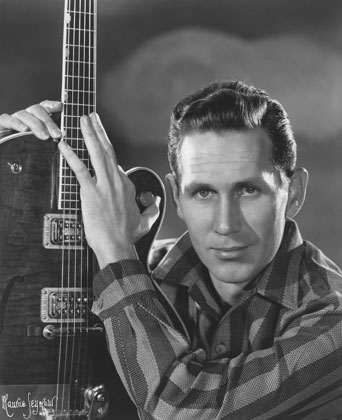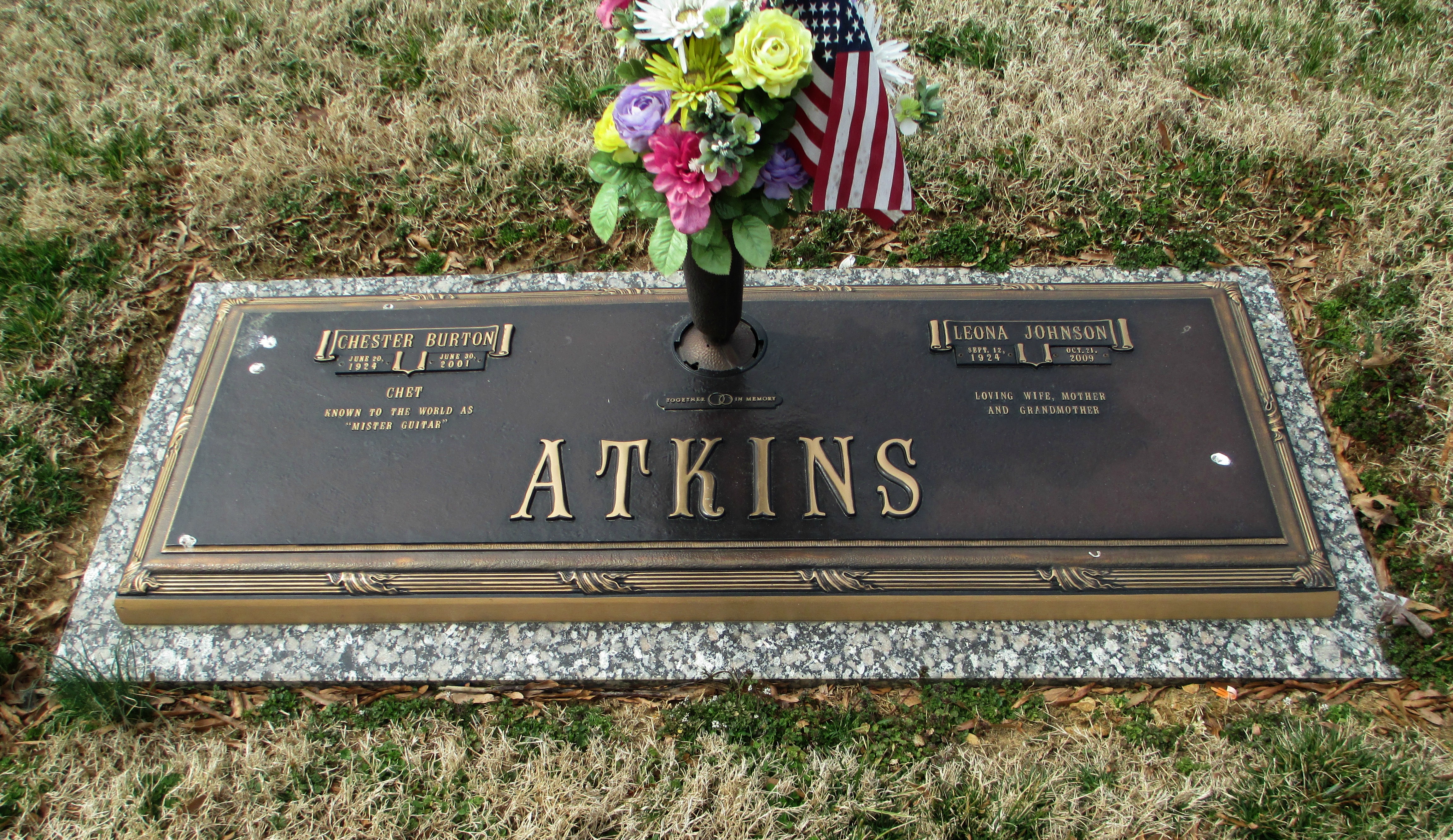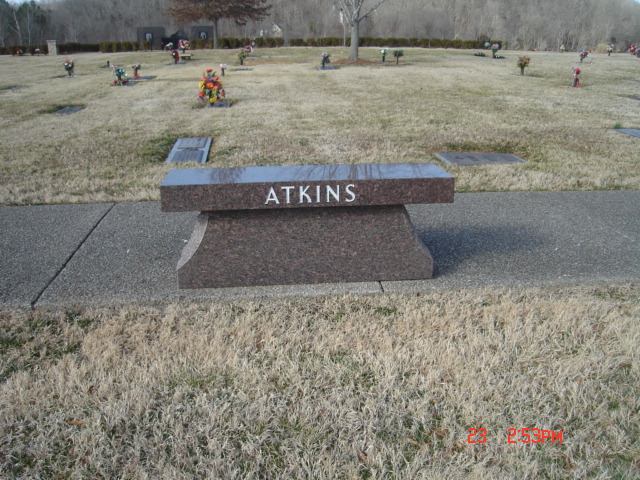Chet Atkins (Chester Burton Atkins)

Chet Atkins
Chet Atkins was born on June 20, 1924, in Luttrell, Tennessee, near Clinch Mountain. His parents divorced when he was six, after which he was raised by his mother. He was the youngest of three boys and a girl. He started out on the ukulele, later moving on to the fiddle, but traded his brother Lowell an old pistol and some chores for a guitar when he was nine. He stated in his 1974 autobiography, “We were so poor and everybody around us was so poor that it was the forties before anyone even knew there had been a depression.” Forced to relocate to Fortson, Georgia, to live with his father because of a critical asthma condition, Atkins was a sensitive youth who made music his obsession. Because of his illness, he was forced to sleep in a straight-back chair in order to breathe comfortably. On those nights, he would play his guitar until he fell asleep holding it, a habit which lasted his whole life. While living in Fortson, he attended historic Mountain Hill School. He would return in the 1990s to play a series of charity concerts to save the school from demolition. Stories have been told about the very young Chet, who, when a friend or relative would come to visit and play guitar, would crowd in and put his ear so very close to the instrument that it became difficult for that person to play.
Atkins became an accomplished guitarist while he was in high school. He would use the restroom in the school to practice, because it gave better acoustics. His first guitar had a nail for a nut and was so bowed that only the first few frets could be used. He later purchased a semi-acoustic electric guitar and amp, but he had to travel many miles to find an electrical outlet since his home had no electricity. Later in life he lightheartedly gave himself (along with John Knowles, Tommy Emmanuel, Steve Wariner, Jerry Reed and Marcel Dadi) the honorary degree CGP, standing for “Certified Guitar Player”. In 2011 daughter Merle Atkins Russell bestowed the CGP degree upon long time sideman Paul Yandell. She then declared no more CGP’s would be allowed by the Atkins estate. His half-brother Jim was a successful guitarist who worked with the Les Paul Trio in New York.
Atkins did not have a strong style of his own until 1939 when (while still living in Georgia) he heard Merle Travis picking over WLW radio. This early influence dramatically shaped his unique playing style. Whereas Travis’s right hand used his index finger for the melody and thumb for bass notes, Atkins expanded his right hand style to include picking with his first three fingers, with the thumb on bass. Chet Atkins was a Ham Radio General class licensee. Formerly using the call-sign, WA4CZD, he obtained the vanity call sign W4CGP in 1998 to reflect the C.G.P. name. He was an ARRL member.
After dropping out of high school in 1942, Atkins landed a job at WNOX-AM radio in Knoxville. There he played fiddle and guitar with singer Bill Carlisle and comic Archie Campbell as well as becoming a member of the station’s Dixieland Swingsters, a small swing instrumental combo. After three years, he moved to WLW-AM in Cincinnati, Ohio, where Merle Travis had formerly worked.
After six months he moved to Raleigh and worked with Johnnie and Jack before heading for Richmond, Virginia, where he performed with Sunshine Sue Workman. Atkins’ shy personality worked against him, as did the fact that his sophisticated style led many to doubt he was truly “country.” He was fired often but was soon able to land another job at another radio station due to his unique playing ability. Atkins and Jethro Burns of Homer and Jethro married twin sisters, Leona and Lois Johnson, who sang as Laverne and Fern Johnson: the Johnson Sisters. Leona Atkins outlived Atkins by eight years, dying in 2009 at the age of 85.
Traveling to Chicago, Atkins auditioned for Red Foley, who was leaving his star position on WLS-AM’s National Barn Dance to join the Grand Ole Opry. Atkins made his first appearance at the Opry in 1946 as a member of Foley’s band. He also recorded a single for Nashville-based Bullet Records that year. That single, “Guitar Blues”, was fairly progressive, including as it did, a clarinet solo by Nashville dance band musician Dutch McMillan with Owen Bradley on piano. He had a solo spot on the Opry; but when that was cut, Atkins moved on to KWTO in Springfield, Missouri. Despite the support of executive Si Siman, however, he soon was fired for not sounding “country enough.”
While working with a Western band in Denver, Colorado, Atkins came to the attention of RCA Victor. Siman had been encouraging Steve Sholes to sign Atkins, as his style (with the success of Merle Travis as a hit recording artist) was suddenly in vogue. Sholes, A&R director of country music at RCA, tracked Atkins down to Denver.
He made his first RCA Victor recordings in Chicago in 1947. They did not sell. He did some studio work for RCA that year but had relocated to Knoxville again where he worked with Homer and Jethro on WNOX’s new Saturday night radio show The Tennessee Barn Dance and the popular Midday Merry Go Round.
In 1949 he left WNOX to join June Carter with Mother Maybelle & The Carter Sisters back on KWTO. This incarnation of the old Carter Family featured Maybelle Carter and daughters June, Helen and Anita. Their work soon attracted attention from the Grand Ole Opry. The group relocated to Nashville in mid-1950. Atkins began working on recording sessions, performing on WSM-AM and the Opry. Atkins became a member of The Opry in the 1950s.
While he had not yet had a hit record on RCA Victor his stature was growing. He began assisting Sholes as a Session Leader when the New York–based producer needed help organizing Nashville sessions for RCA Victor artists. Atkins’s first hit single was “Mr. Sandman”, followed by “Silver Bell”, which he did as a duet with Hank Snow. His albums also became more popular, and he was featured on ABC-TV’s The Eddy Arnold Show during the summer of 1956; as well as on Country Music Jubilee in 1957 and ’58 (by then renamed Jubilee USA).
In addition to recording, Atkins became a design consultant for Gretsch, who manufactured a popular Chet Atkins line of electric guitars from 1955–1980. Atkins also became manager of RCA Victor’s Nashville studio, eventually inspiring and seeing the completion of the legendary RCA Studio B, the first studio built specifically for the purpose of recording on the now-famous Music Row.
When Sholes took over pop production in 1957—a result of his success with Elvis Presley—he put Atkins in charge of RCA Victor’s Nashville division. With country music record sales declining as rock and roll took over, Atkins and Bob Ferguson took their cue from Owen Bradley and eliminated fiddles and steel guitar as a means of making country singers appeal to pop fans. This became known as the Nashville sound which Atkins said was a label created by the media attached to a style of recording done during that period to keep country (and their jobs) viable.
Atkins used the Jordanaires and a rhythm section on hits like Jim Reeves’ “Four Walls” and “He’ll Have to Go” and Don Gibson’s “Oh Lonesome Me” and “Blue Blue Day”. The once rare phenomenon of having a country hit cross over to pop success became more common. He and Bradley had essentially put the producer in the driver’s seat, guiding an artist’s choice of material and the musical background.
Atkins made his own records, which usually visited pop standards and jazz, in a sophisticated home studio, often recording the rhythm tracks at RCA but adding his solo parts at home, refining the tracks until the results satisfied him. Guitarists of all styles came to admire various Atkins albums for their unique musical ideas and in some cases experimental electronic ideas. In this period he became known internationally as “Mister Guitar”, inspiring an album named Mister Guitar, engineered by both Bob Ferris and Bill Porter, Ferris’s replacement.
At the end of March 1959, Porter took over as chief engineer at RCA’s Nashville studio, in the space now known as “Studio B”. (At the time there was only one RCA studio in Nashville, with no letter designation.) Porter soon helped Atkins get a better reverberation sound from the studio’s German effects device, an EMT plate reverb. With his golden ear, Porter found the studio’s acoustics to be problematic, and he devised a set of acoustic baffles to hang from the ceiling, then selected positions for microphones based on resonant room modes. The sound of the recordings improved significantly, and the studio achieved a string of successes. The Nashville sound became more dynamic. In later years, when Bradley asked how he achieved his sound, Atkins told him “it was Porter.” Porter described Atkins as respectful of musicians when recording—if someone was out of tune he would not single that person out by name. Instead, he would say something like, “we got a little tuning problem … Everybody check and see what’s going on.” If that didn’t work, Atkins would instruct Porter to turn the offending player down in the mix. When Porter left RCA in late 1964, Atkins said, “the sound was never the same, never as great.”
Atkins’s trademark “Atkins Style” of playing uses the thumb and first two—sometimes three—fingers of the right hand. He developed this style from listening to Merle Travis occasionally on a primitive radio. He was sure no one could play that articulately with just the thumb and index finger (which was exactly how Travis played) and he assumed it required the thumb and two fingers—and that was the style he pioneered and mastered.
He enjoyed jamming with fellow studio musicians which led to them being asked to perform at the Newport Jazz Festival in 1960. Although that performance was canceled due to rioting, a live recording of the group (After the Riot at Newport) was released. Atkins performed by invitation at the White House for presidents Kennedy through George H. W. Bush. Atkins was a member of the Million Dollar Band during the 1980s. He is also well known for his song “Yankee Doodle Dixie”, in which he played “Yankee Doodle” and “Dixie” simultaneously, on the same guitar.
Before his mentor Sholes died in 1968, Atkins had become vice president of RCA’s country division. In 1987 he told Nine-O-One Network Magazine that he was “ashamed” of his promotion: “I wanted to be known as a guitarist and I know, too, that they give you titles like that in lieu of money. So beware when they want to make you vice president.” He had brought Waylon Jennings,Willie Nelson, Connie Smith, Bobby Bare, Dolly Parton, Jerry Reed and John Hartford to the label in the 1960s and inspired and helped countless others. He took a considerable risk during the mid-1960s, when the Civil Rights Movement sparked violence throughout the South by signing country music’s first African-American singer Charley Pride, who sang rawer country than the smoother music Atkins had pioneered.
Atkins’s own biggest hit single came in 1965, with “Yakety Axe”, an adaptation of his friend saxophonist Boots Randolph’s “Yakety Sax”. He rarely performed in those days, and eventually had to hire other RCA producers like Bob Ferguson and Felton Jarvis to alleviate his workload.
In the 1970s, Atkins became increasingly stressed by his executive duties. He produced fewer records but could still turn out hits such as Perry Como’s pop hit “And I Love You So”. He recorded extensively with close friend and fellow picker Jerry Reed, who’d become a hit artist in his own right. A 1973 diagnosis of colon cancer, however, led Atkins to redefine his role at RCA, to allow others to handle administration while he went back to his first love, the guitar, often recording with Reed or even Homer & Jethro’s Jethro Burns (Atkins’ brother-in-law) after Homer died in 1971.
By the late 1970s, RCA decided to remove Atkins from his producing duties and replace him with younger men. He also felt stifled because the record company would not let him branch into jazz. His mid-1970s collaborations with one of his influences, Les Paul, Chester & Lester and Guitar Monsters, had already reflected that interest; Chester & Lester was one of the best-selling recordings of Atkins’s career. At the same time he grew dissatisfied with the direction Gretsch (no longer family-owned) was going and withdrew his authorization for them to use his name and began designing guitars with Gibson. Atkins ended his 35 year association with RCA in 1982 and signed with Columbia Records, for whom he produced a debut album in 1983.
Jazz had always been a strong love of his, and often in his career he was criticized by “pure” country musicians for his jazz influences. He also said on many occasions that he did not like being called a “country guitarist”, insisting that he was a guitarist, period. Although he played ‘by ear’ and was a masterful improviser he was able to read music and even performed some classical guitar pieces. When Roger C. Field, a friend, suggested to him in 1991 that he record and perform with a female singer he did so with Suzy Bogguss.
He returned to his country roots for albums he recorded with Mark Knopfler and Jerry Reed. Knopfler had long mentioned Atkins as one of his earliest influences. Atkins also collaborated with Australian guitar legend Tommy Emmanuel. On being asked to name the ten most influential guitarists of the 20th century, he named Django Reinhardt to the first position, and also placed himself on the list. In later years he even went back to radio, appearing on Garrison Keillor’s Prairie Home Companion radio program, on American Public Media radio, even picking up a fiddle from time to time.
Atkins received numerous awards, including 14 Grammy Awards and nine Country Music Association Instrumentalist of the Year awards. In 1993 he was honored with the Grammy Lifetime Achievement Award. Billboardmagazine awarded him their Century Award, their “highest honor for distinguished creative achievement”, in December 1997.
Atkins is notable for his broad influence. His love for numerous styles of music can be traced from his early recording of stride-pianist James P. Johnson’s “Johnson Rag,” all the way to the rock stylings of Eric Johnson, an invited guest on Atkins’s recording sessions who, when Chet attempted to copy his influential rocker “Cliffs of Dover,” led to Atkins’s creation of a unique arrangement of “Londonderry Air (Danny Boy).”
Chet’s recordings of “Malagueña” inspired a new generation of Flamenco guitarists; the classical guitar selections included on almost all his albums were, for many American artists working in the field today, the first classical guitar they ever heard. He recorded smooth jazz guitar still played on American airwaves today.
Atkins continued performing in the 1990s, but his health declined after being diagnosed again with cancer in 1996. He died on June 30, 2001, at his home in Nashville, Tennessee.
Atkins was buried at Harpeth Hills Memory Gardens in Nashville. A stretch of Interstate 185 in southwest Georgia (between LaGrange and Columbus) is named “Chet Atkins Parkway”. This stretch of interstate runs through Fortson, GA where Atkins spent much of his childhood.
In 2002, Atkins was posthumously inducted into the Rock and Roll Hall of Fame. His award was presented by Marty Stuart and Brian Setzer and accepted by Atkins’s grandson, Jonathan Russell. The following year, Atkins ranked No.28 in CMT’s 40 Greatest Men of Country Music. At the age of 13, jazz guitarist Earl Klugh was captivated watching Atkins’s guitar playing on The Perry Como Show. Similarly he was an extremely big influence on Doyle Dykes. Atkins also inspired Drexl Jonez and Tommy Emmanuel.
Clint Black’s album “Nothin’ but the Taillights” includes the song “Ode to Chet,” which includes the lines “‘Cause I can win her over like Romeo did Juliet, if I can only show her I can almost pick that legato lick like Chet” and “It’ll take more than Mel Bay 1, 2, & 3 if I’m ever gonna play like CGP.” Atkins plays guitar on the track. At the end of the song Black and Atkins have a brief conversation. Chet’s song Jam Man is currently used in commercials for Esurance.
The opening guitar licks to the Miranda Lambert song Only Prettier sound very similar to Chet Atkins’s guitar picking style. In 1967, a tribute song called “Chet’s Tune” was produced for his birthday, with contributions by a long list of RCA/Victor artists including Eddy Arnold, Connie Smith, Jerry Reed, Willie Nelson, Hank Snow, and others. The song was written by Nashville songwriter Cy Coben, a friend of Atkins. The single reached No. 38 on the country charts.
In 2009, Steve Wariner released an album entitled My Tribute to Chet Atkins. One song from that record, “Producer’s Medley”, featured Wariner’s recreation of several very famous songs which Chet Atkins both produced and performed on. In 2010, “Producer’s Medley” won the Grammy for Best Country Instrumental Performance. In November of 2011, Rolling Stone ranked Atkins #21 on its list of the 100 greatest guitarists of all time.
Born
- June, 20, 1924
- Luttrell, Tennessee
Died
- June, 30, 2001
- Nashville, Tennessee
Cause of Death
- Heart attack
Cemetery
- Harpeth Hills Memory Gardens
- Nashville, Tennessee








